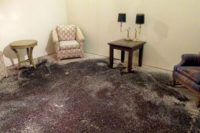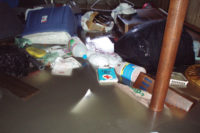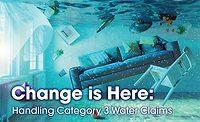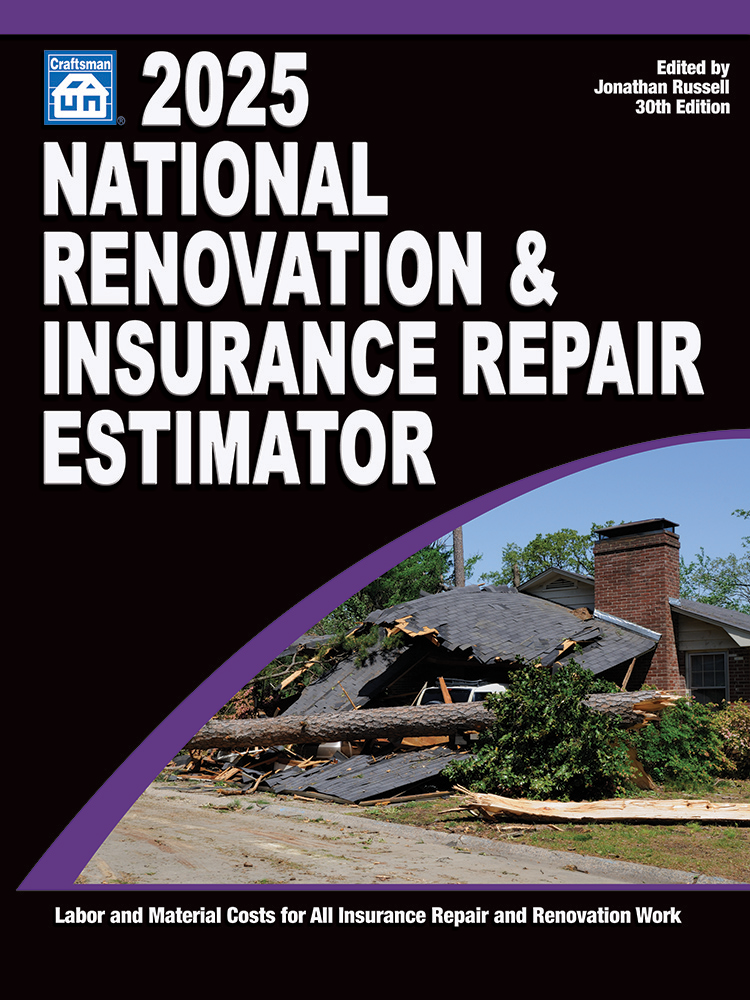Beware! Your Category 3 Water Jobs Are Likely Uninsured
Give this article to your insurance agent and tell them that you work at Category 3 water job sites






Every IICRC-certified water damage restoration contractor knows Category 3 water is classified as Category 3 because it is grossly contaminated with fungi, bacteria or other pollutants. However what no one seems to know - especially insurance agents/brokers and claims adjusters - is that universal exclusions in property and liability insurance policies for losses “related to” fungus/bacteria automatically apply to Category 3 water losses. Insurance coverage gaps for losses associated with Category 3 water must be filled using the same risk mangement tools and environmental insurance products created for fungi/mold risks in 2003.
If a restoration job involves the clean-up or assessment of a minute quantity of Category 3 water, any loss arising from the job site - like a fire caused by the contractor - can be excluded through the effects of universal fungi/bacteria exclusion in insurance policies. Even carpet cleaners are running completely bare on a job where a single speck of Category 3 water was cleaned up.
Category 3 water automatically triggers two different exclusions in insurance policies:
- The pollution exclusion
- The fungi/bacteria exclusion
IICRC-certified professional water restoration technicians have learned in their certification courses that there are three categories of water. The information below is taken directly from the S500 Standard:
- Category 1: Originates from a sanitary source
- Category 2: Contains significant contamination
- Category 3: Is grossly contaminated and can contain pathogenic, toxigenic or harmful agents
“Contaminates” is an operative word in pollution exclusions universally found in property and liability insurance policies. Many of the contaminants referenced in the definition of Category 3 water in the S500 Standard technically trigger both pollution exclusions and fungus/bacteria exclusions.
The words “Category 3 water” do not appear in insurance policies. To find where losses related to Category 3 water became excluded, all one has to do is look for the word “bacteria” or “contamination” in insurance contracts. The word “bacteria” appears in exclusions commonly referred to by insurance practitioners as “mold exclusions.” “Bacteria” appears after the word “fungus” in these widely used exclusions. By default, “mold exclusions” apply to Category 3 water as well. The word “contaminant” is found in all pollution exclusions.
Because Category 3 water by definition is Category 3 because of the bacteria it contains along with other contaminants, everywhere the word “bacteria” appears in an insurance policy, the words “Category 3 water” can be inserted. In the vast majority of cases, the right coverage determination will be reached.
Although the actual exclusions for losses associated with fungus and bacteria in general liability (GL) insurance policies do vary, the exclusions for these contaminants usually have common elements. These common elements include:
- The exclusion applies to fungus, mold and bacteria because they are often found living together.
- The exclusion will have an anti-concurrent causation section (like a flood exclusion) to eliminate coverage arguments that some other covered cause of loss was the real cause.
- There will usually be two parts of the exclusion endorsement, the first part which addresses damages associated with actual or perceived exposure to fungus, mold and bacteria. The second part of the exclusion eliminates all of the insurance coverage in the policy on a job site, where a contractor has any involvement whatsoever in remediating or assessing fungus, mold or bacteria, which then, by definition, would automatically include all job sites with a drop of Category 3 water involved in the scope of work.
- The exclusions never limit their scope to any particular species or measurable amount of fungus, mold or bacteria. Therefore the cleanup or assessment of a microscopic speck of any species of these materials technically triggers the full effect of the exclusion over the entire job site.
Purchasing contractors pollution liability (CPL) insurance cannot fill the gap in coverage on the GL policy created by a “you cannot be at this job site exclusion.” The CPL policy only pays for damages caused by a release of “pollutants/contaminants.” Burning down a house at a Category 3 water job has nothing to do with exposure to contamination, therefore the CPL policy will not pay the fire loss. The GL policy with a fungi/bacteria exclusion technically excludes all losses from the Category 3 water job site, so it will not pay for the fire either. Unless of course the GL claims adjuster never figures out that the project was related to Category 3 water cleanup, in which case the fire would be a simple property damage loss which is covered in the off-the-shelf GL policy. Depending on the claims adjuster to miss the link to Category 3 water to get a claim paid is not a reliable insurance design.
Today more than 90% of water restoration firms needlessly go to work every day without reliable liability insurance. The main reasons this situation exists are:
- 99.5% of insurance agents have never heard of Category 3 water.
- Insurance agents have never been trained on the effects of pollution/ fungus/bacteria/Category 3 water exclusions, and, until very recently, there has been no venue for them to be trained in these subjects.
- The commission rates on traditional GL insurance sales can be twice as high as the commission paid on a customized liability insurance policy for a restoration contactor.
- It is common for customized insurance packages with Category 3 water coverage to cost less than separate GL and CPL policies, which means the insurance agent makes a lower commission percentage on a lower amount of insurance premium.
- It is common for restoration firms to be insured under package insurance policies that include other lines of insurance coverage like property, automobile and workers compensation insurance. Moving the GL coverage can “blow up” the package in insurance agent terminology, which results in more work for the agent as they scramble to place the other lines of coverage into the insurance market which typically black lists restoration contractors in general as unacceptably risky business.
With this “let’s put it all out on the table” background, it is easy to understand why 90% of insurance agents sell fundamentally flawed GL insurance to restoration firms. After all, why would anybody choose to work harder for ½ the pay if they saw no purpose in the additional work? This is why you need to give this article to your insurance agent and tell them that you work at Category 3 water job sites.
Most insurance agents are driven by doing what is right for their customer and never consider how much more commission they can make by doing the wrong thing.
An added benefit for your insurance agent in fixing a Category 3 water coverage gap is that in doing so it makes it much less likely that you will ever be looking in desperation to your insurance agent to pay for a denied Category 3 water-related claim under the insurance agent’s malpractice insurance policy.
Virtually all the agents that sell the flawed GL policies think everything is fine in the coverage and there is a remote chance that it is. In theory, the standard GL insurance policy can be adapted to insure Category 3 water job sites. However that GL policy would need to have these features in order to work at all:
- It cannot have a fungus or bacteria exclusion for all losses arising from the job site itself, and
- Fungus/bacteria need to be specifically exempted from the definition of a “pollutant.”
In reviewing the actual insurance policies on over a thousand restoration firms in our insurance consulting practice, I have never seen a GL policy with either one of these two needed provisions. I am pretty sure a GL insurance policy with these provisions does not exist at any price anywhere in the U.S. or Canada. If your insurance agent says your GL policy is fine, get it in writing - it will make that call from you to your agent a lot less desperate in the face of denied Category 3 water-related loss.
Insurance claims adjusters will eventually figure out the connection between Category 3 water and the universal exclusions for fungi/bacteria in property and liability insurance policies. In anticipation of more coverage denials on losses related to Category 3 water, restoration firms and their insurance agents needs to fill the gaps in insurance coverage created by fungus/bacteria exclusions on a proactive basis.
Insurance coverage solutions for virtually all sources of Category 3 water-related losses are readily available in the environmental insurance marketplace and have been for more than seven years. However, if your insurance agent has never heard of Category 3 water, it would be impossible for them to recognize the effects of the fungi/bacteria exclusion on your business liability insurance.
The solutions to the Category 3 water/mold insurance coverage gaps are affordable, widely available and simple to implement. But you will need to start the solution process by handing your insurance agent this article and informing them how often you run into job sites with a speck of Category 3 water that you need to clean up.
A version of this article first appeared in the Expert Commentary section of IRMI.com, the website of International Risk Management Institute, Inc. Further reproduction without permission of IRMI is prohibited.
Looking for a reprint of this article?
From high-res PDFs to custom plaques, order your copy today!












